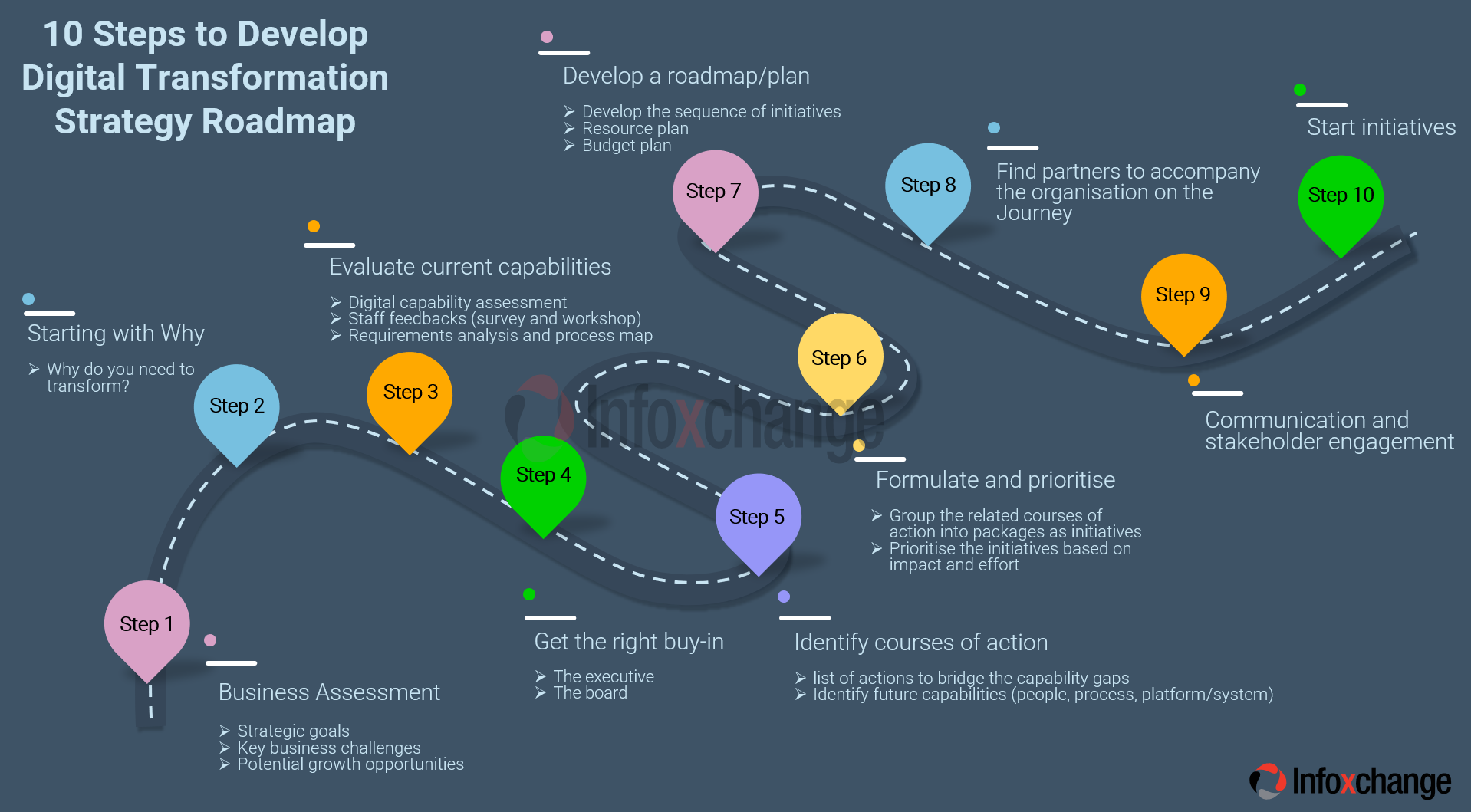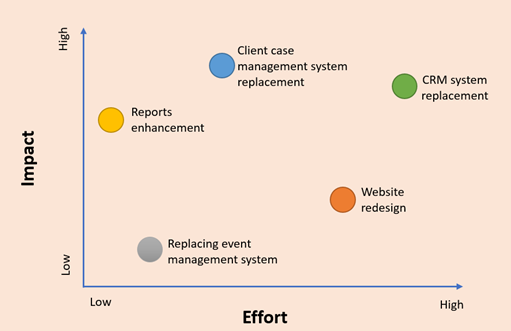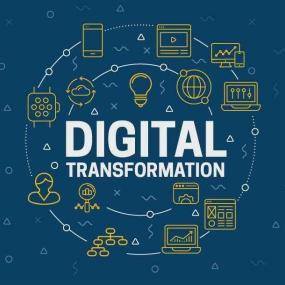Digital transformation is a journey. The journey doesn’t take place overnight. It’s a gradual process that involves people, process and technology. Reaching that destination requires leadership with the will to rethink how an organisation goes about its business. But the end-goal is the implementation of digital technologies that will:
- improve client outcomes and supporter engagement
- enhance decision-making
- increase efficiency and productivity
- promote innovation.
This guide isn’t a universal framework. It’s a roadmap that highlights some key elements that will be relevant to most not-for-profits.

Step 1: Organisation assessment
While not-for-profits aren’t commercially driven, they still need to follow certain standards to be successful. They may come in all different shapes and sizes but they have something in common: the need for more effective ways to provide services, improve and adapt to emerging needs.
The digital transformation journey needs to spring from business strategy and organisational direction. Before starting the journey, your organisation should clarify strategic goals, organisational values, key challenges, business weaknesses/pain points, and potential growth opportunities.
Step 2: Starting with Why
Chances are the first thing you think of when you picture digital transformation in your organisation is acquiring something new, like a website, Office 365, CRM or finance system. Instead, start with the why: why do you need a new technology, and what’s the objective of your digital transformation?
There is a framework known as the Golden Circle, coined by Simon Sinek, author of Start With Why, to help organisations start initiatives such as new projects, programs, products or services. It tasks organisations with answering three questions for each initiative:
- Why, or the purpose
- How, or the process
- What, or the result.
The same principles can logically be applied to digital technology. Many organisations struggle to answer these questions before starting a digital transformation journey.
- Why do you need to transform?
- How is digital transformation achieved?
- What will digital transformation mean to your organisation?
By understanding why you need digital transformation, you can link business strategy to future digital transformation strategy.
Step 3: Evaluate current digital capabilities
Next, you need to assess what digital capabilities you have (people, process, platform/technology).
1) Digital capability survey
Our digital transformation survey is designed to assess an organisation's digital capability, and has 28 questions across the five technology domains:
- Tech foundations
- Information systems
- Digital marketing
- IT management
- Cyber security.
Once you have completed the quiz, your organisation's digital capability (basic, intermediate or advanced) will be shown for each of the five technology domains. Your organisation can then prioritise the domains they need to prioritise. In each domain, you’ll be able to:
- review business processes and highlight inefficiencies
- identify technology gaps or areas where your existing systems fall short
- define functional capabilities needed to effectively support or improve your processes.
2) Digital technology assets register
Digital technology assets register helps you to Keep track of what you own, its capabilities, warranties and when it needs replacing, will be integral to any digital technology planning or budgeting you have to do.
3) Staff feedback
After that it’s a good idea ask for staff feedback to understand what the problems are that you are trying to solve. You can use different techniques to capture feedback, such as surveys and workshops.
- Staff surveys: You can set up a survey easily and for free using a tool such as Survey Monkey or Microsoft Forms. Questions don’t need to be complicated; you’re just trying to give everyone a chance to provide feedback about what would help them in their jobs and set a baseline against which you can measure future improvement.
- Workshops: Running an all-staff meeting or series of workshops could help tease out some of the challenges that could be solved by investment in digital technology. You can also hear any ideas staff have to solve these problems and get a feel for what might be the priority areas to address. Staff will also be able to share any concerns they have about increasing your investment in digital transformation, which will help bring them along on the transformation journey.
4) Requirement gathering and high-level process capturing
Next, you can start writing a list of pain points and potential improvements, such as service delivery, training and education, human resources. Then you can start to map the high-level process. A useful diagrammatic tool is SIPOC, which charts suppliers, inputs, process, outputs and customers (hence the name).
Lastly, based on the complexity level of process (basic to advanced), it’s good to capture high-level requirements as a potential opportunity. Learn more about how to start requirements gathering.
Step 4: Get the right buy-in
The success of a digital transformation depends to a large degree on the culture of an organisation. If the leadership team doesn't buy into or understand the process, it runs the risk of running aground when change is necessary but those implementing that change don’t have the authority to do so or the backup they need when it’s required.
This is a key step to getting a digital transformation project off the ground and running – and to ensuring the necessary organisational investment. Here are some steps that need to be considered to gather leadership team buy-in:
- Identify the best champion for the project or initiative in the leadership team, who can then act as an influencer
- Anticipate sources of resistance, identify areas of concern and motivations, and identify mitigation strategies
- Start with main reasons for embarking on a digital transformation journey, listing issues to address, and counter those with solutions and opportunities
- Pitch the idea using research and in terms of value to the organisation
- Try to clarify potential obstacles and challenges
- Explain their role as the champion in the digital transformation journey, the journey itself, and how they can add value
- Get their commitment
- Start the conversation: speak a language that your executive team can relate to. By knowing their pain points and their passions, you can start a conversation that attracts their interest and holds their attention.
Step 5: Identify courses of action
After completing a capability audit, the organisation needs to build a list of actions to bridge the capability gaps. These actions need to consider the people, process, and platform/technology change.
In this stage you need to identify potential future capabilities. For example, for a fundraising management capability, a ‘people’ course of action could be to appoint a dedicated fundraising support person; a ‘process’ course of action could be to enhance the donation process to cater for online donation opportunity management; and a ‘platform/technology’ course of action could be to implement a donor management system.
Step 6: Formulate and prioritise initiatives
Now that you know the key challenges and gaps and you’ve identified the required courses of action, you can proceed. Go through the required actions and group the related ones together into packages of work. These are your initiatives, projects or programs. What you call them will be based on your own preferences, as well as the scope and complexity.
These initiatives could range from external changes, such as changes to products or services, or improvements to client experiences, to internal transformation such as cloud and technology infrastructure. Or it might be a combination of the two. It might even be just one small change. Regardless, it is always crucial to remember the three aspects to any digital transformation: people, process, and platform.
Each digital initiative will vary in scope, resources and return-on-investment. Prioritise initiatives based on their impact and estimated effort. Start with simple projects with essential features to test your digital solution’s viability.

Step 7: Develop a roadmap and plan
After exploring options, prioritising them, and obtaining the right buy-in, you need to formulate a plan. This is where you determine the sequence and delivery schedule.

Ensuring the initiatives are adequately resourced is the key. You can’t tackle everything at once. Assemble a team with the right skills and mindset to put your strategy into action. Your roadmap should incorporate a realistic schedule and timeline for each initiative based upon priorities, the duration of the initiative and available resources.
Most digital transformation journey fail because of insufficient budget. When you create a budget plan, anticipate delays and plan for when new technology makes current investments obsolete. Make sure you research pricing and include a realistic cost estimate for each project in the roadmap.
Read more about how to budget for digital technologies.
Step 8: Find partners to accompany the organisation on the journey
The biggest challenge organisations face with a digital transformation is not having the internal expertise to take on the initiative. One effective way to relieve the workload on your in-house staff is using external resources like volunteers, consultants or service providers.
For a small technology project, you can engage with volunteers to help you on the journey. For bigger projects, you need to work with consultants. They accompany the organisation throughout the digital transformation journey and contribute their experience to ensuring the organisation makes the right decisions. The partners can add value in strategy, services, technology, change management and training.
Learn how you can recruit the support of an external partner and what steps to take to get the right level of support. Read more about managing contractual arrangements with partners.
Book a free consultation session to discuss your digital transformation journey.
Step 9: Communication and stakeholder engagement
Telling staff what is going on will motivate them to lend their support to the digital transformation journey. If people understand what is happening and why, they are more likely to support the changes. If the value of a transformation is not communicated well, the organisation may struggle to get buy-in from staff, which could act as a hindrance later on in the process.
In the communication and stakeholder plan, you should decide what you want to say and who you want to say it to. Is it internal staff or external groups like sponsors? Identify the best channels, the right frequency, and the tone of the language you use.
Step 10: Start executing initiatives
After identifying the objectives, challenges and current digital capabilities, defining initiatives and developing plans, review it with a critical eye – is it realistic or are you trying to achieve too much? Is it justified? Are the benefits that you’ll receive from the actions enough to justify the cost and effort?
Once you’re happy with it, it is time to get formal approval and start executing the initiatives. Remember, it is best to test ideas as you go through the process. Make sure you align any requests with the appropriate schedule. For example, if your financial year is July-June, you might need to have the draft plan finalised in April or May for inclusion in next year’s budget.
Once the plan has been approved, it’s a matter sticking to it and reviewing it regularly to ensure that things are on track, or refine if you need to.
As a final step, learn the main reasons why digital transformation projects fail and the most important factors that determine success in your digital transformation.
There is no ‘perfect’ structure for a digital transformation strategy roadmap – it is about choosing a structure that is right for your organisation. Download our
sample digital transformation strategy roadmap
Read next
For comprehensive training, including courses and webinars, see our guide to IT strategy, planning and management.





Status message
Thanks for rating this guide.